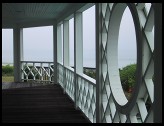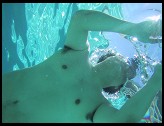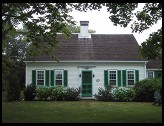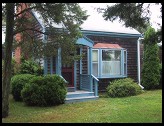
Canon S100 (Digital ELPH)
by Philip Greenspun; created 2000
Site Home : Photography : Canon S100 (Digital ELPH)

by Philip Greenspun; created 2000
Site Home : Photography : Canon S100 (Digital ELPH)
The young green sea turtle came up to breathe just six feet from me. I was snorkeling around a coral reef in the Whitsunday Islands, off the coast of Queensland, Australia. We swam together for a minute or so. The turtle was neither afraid nor especially curious. I raised my Canon S100, secure in its Canon AW-PS200 underwater housing, to my SCUBA mask. The LCD screen on the back of the camera clearly proclaimed "battery low".
I did not get the turtle photo.
Such is life with a digital camera. For underwater use I'd kept the LCD screen on and the flash firing with every picture. The 192 MB flash card made me snap happy and I'd exhausted the tiny Lith-ion battery pack on a banal coral image.
The S100, introduced in February 2000, was the first truly shirt-pocketable digital camera. It is sometimes called the "Digital ELPH" in the United States and "Ixus" in other countries. It was half to two-thirds the size of comparable quality point-and-shoot digital cameras with no compromise in performance or features and no price premium. It costs about $600 (October 2000).
 The S100 is the only digital camera for
which the manufacturer produces an underwater case. This rigid case makes the
camera ideal for snorkelers and rainy day photographers though its 10-foot
pressure rating limits its utility for SCUBA. All controls are easy to use from
the stalks that come out the plastic AW-PS200 housing (about $200).
The S100 is the only digital camera for
which the manufacturer produces an underwater case. This rigid case makes the
camera ideal for snorkelers and rainy day photographers though its 10-foot
pressure rating limits its utility for SCUBA. All controls are easy to use from
the stalks that come out the plastic AW-PS200 housing (about $200).
Controls are reasonably intuitive and analogous to film cameras. Never having used a digital camera before, I was able to operate the unit without referring to the owner's manual. The only thing that sent me digging into the manual was the camera's default behavior of forgetting all custom settings after being powered off. Within five minutes I was able to set the camera to power up with whatever image quality and flash settings had been previously set.
The camera is rated for ISO 100 sensitivity and indeed its behavior is what you'd expect a point and shoot camera with a slow lens and ISO 100 film. Indoor images without flash tend to be blurry and grainy unless you're careful to steady yourself by leaning against a wall.
Even at superfine resolution, the 1600x1200-pixel images are not very sharp when viewed at 100%. See this ferris wheel for example. The problem may have been the typical point and shoot unwillingness to focus at infinity because these flowers look better. The camera has poor dynamic range. Highlights become easily washed out. Here are some examples:
 The image at left looks pretty good with
an unchallenging scene.
The image at left looks pretty good with
an unchallenging scene.
 The gray roof at right is
completely washed out even though it didn't look too much brighter to the human
eye and film would certainly have captured detail in the roof.
The gray roof at right is
completely washed out even though it didn't look too much brighter to the human
eye and film would certainly have captured detail in the roof.
Lag times are long and unpredictable. It takes a second or two after powering up before you can zoom the 35-70mm lens. There is a lot of lag between when you press the shutter release and when the image is captured. This is not the camera with which you're going to capture the decision moment.
The S100 survived months of being in a front pants pocket with keys, change, and a mobile phone. It survived Australian salt air, desert dust, and humidity.
Canon ships the S100 with easy to use software for managing images downloaded from the camera. I was able to install and use it on a Windows 2000 machine without reading the manual. Images can be downloaded via a USB cable from the camera or by removing the flash card and inserting it into either a desktop USB adaptor or a PC card adaptor. Using the PC card adaptor and a Windows 2000 notebook computer, the images show up as standard JPEGs in the Windows file system.
The other software that comes with the S100 is panoramic stitching software. It was easy to use and effective.
The S100 is a great vacation camera. It doesn't work for artistic available light photography.
Text and photos (c) Copyright 2000 Philip Greenspun.